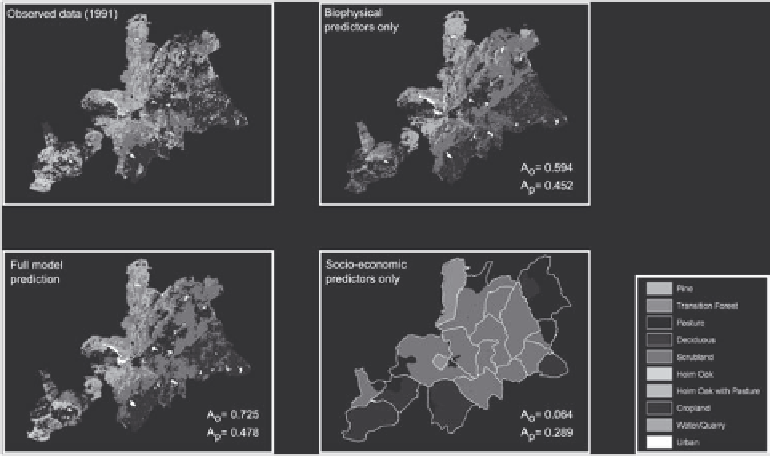Geoscience Reference
In-Depth Information
models. First, statistical models of LUCC often assume that rates of change are
stationary either in space or time or in both. Second, there are scale-related issues
arising from the ecological fallacy and the modifi able area unit problem. Finally,
the way in which change is represented is restricted by the limited way that relation-
ships between predictor and dependent variables can be represented mathematically.
In essence, the question to ask is 'how much can an empirical-statistical model illu-
minate process and causality?'
Millington et al. (2007) used empirical-statistical models in an effort to both
understand and predict LUCC in the SPA 56 (central Spain). The SPA 56 is a
heterogeneous and dynamic landscape comprising a range of land uses including
agriculture, urban, peri-urban, recreation and forestry; it is designated a special
protection area under the EU's 'Bird Directive' (Natura-2000 scheme). As in much
of Mediterranean Europe this area has seen considerable land abandonment since
the 1960s, largely driven by the decline of the traditional rural economy and rural-
to-urban migration. Using satellite imagery, categorical maps and census informa-
tion, Millington et al. (2007) derived statistical models of LUCC in the SPA 56.
They employed multinomial logistic regression models, whose predictions were
evaluated on the basis of pixel-by-pixel comparisons and by comparing the accuracy
of the statistical models with a null model of zero change in the landscape (fi gure
20.1). The multinomial models suggested that the transformation of agricultural
land to scrubland will continue into the future. Millington et al.'s predictive models
Figure 20.1
An example of confrontational-type model evaluation. Multinomial
regression models containing different predictor sets (a full 'saturated' model, a model
using only biophysical predictors and a model using only socio-economic predictors)
were used to predict landscapes in the SPA-56, Central Spain. The predictions (for
1991) are compared with observed data (from 1991) on the basis of overall composi-
tion (
A
o
) and pixel-by-pixel (
A
p
) accuracy (proportional); analyses conducted by James
Millington.






